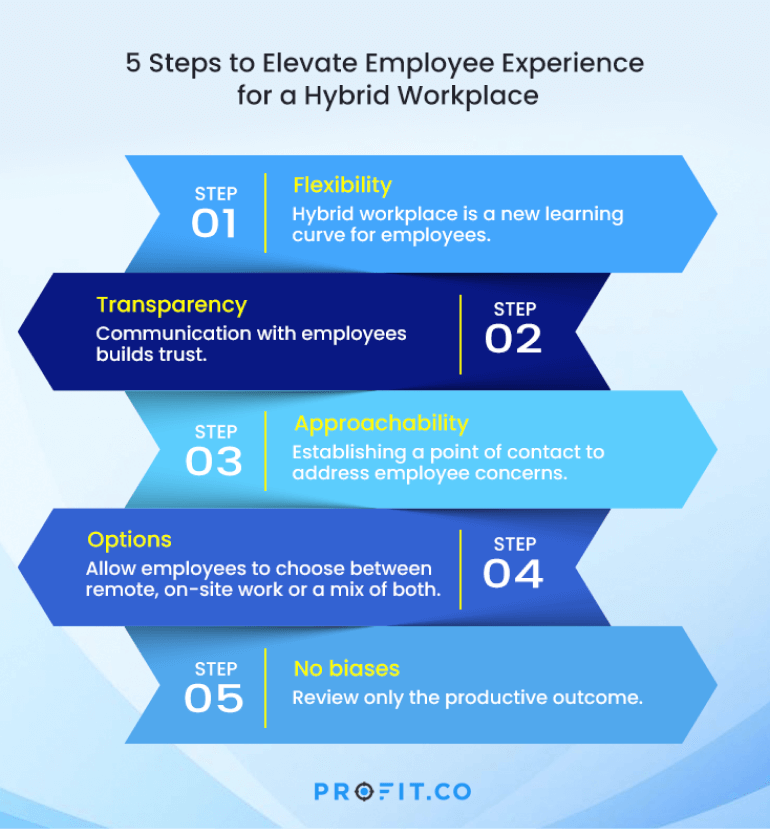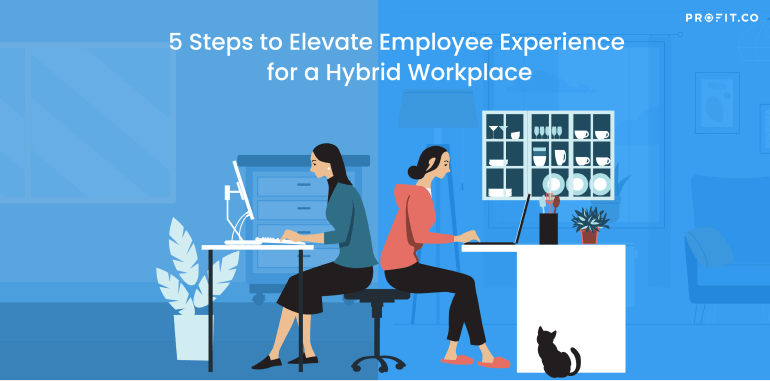The past two years have changed the way people work. The impact the pandemic has had on the workplace, and the way of working, is not going to go away soon. In fact, it has created a new style of working which is being called now as the ‘new normal’. That said, the resources that we need to be efficient and productive while we work remotely or as we move toward a hybrid culture of work are different from what they were during pre-pandemic days. No one size fits all and therefore, organizations need to make sure to have a thorough understanding of the organization’s business needs to come up with solutions that are designed to increase productivity, and also seamlessly integrate with how employees currently work.
Following are 5 ways in which organizations can elevate employee experience for a successful hybrid workplace:
- Be flexible. It’s a learning curve for everyone.
- Be open and transparent to build trust
- Have a point of contact to address any concerns employees may have
- Keep remote work as an option
- No biases
Success in a hybrid work environment requires employers to move beyond viewing remote or hybrid environments as a temporary or short-term strategy and to treat it as an opportunity.
1. Be flexible. It’s a learning curve for everyone.
As cliche as it might sound, even after two years, the truth is that it still is ‘unprecedented times’. The transition is new for everyone. Workplaces and employees must acknowledge that everyone is trying to maneuver change. Nobody has all the answers, so accept that with an open mind. There are going to be a lot of concerns about commuting, childcare arrangements, about how the whole hybrid setup will work – these are all valid concerns. It takes flexibility and patience to work things out.
If possible, do a pilot test with the hybrid work setup. It’s a good way to see what works and what doesn’t, which will help smoothen things out before deploying it on a larger scale.
Want to get started on an intuitive and agile OKR software to enhance your employee engagement and employee development? Start your free trial of Profit.co!
2. Be open and transparent to build trust
Being open and transparent goes a long way in building trust. But with everyone working remotely and moving toward a hybrid culture, it’s hard to use the same tools as in pre-pandemic days to be open and transparent with employees. One of the tried and tested tools to improve communication across the organization is to implement OKRs, a comprehensive goal management system using an agile software. This will improve employee communication and transparency across the organization. Managers can ensure OKR transparency by aligning the entire team to the organizational objectives. Improving the visibility of remote employees is an essential part of making the hybrid model work.
Examples of what would work are:
- Employee surveys
Create employee surveys and feedback sessions to identify the concerns and challenges employees might face as they transition into a hybrid work setup. These employee satisfaction surveys will help managers to be open with employees and have a discussion about the plans to address them.
- Q&A with heads of departments
Have a Q&A session with heads of departments for employees to address and ask any questions the employees may have. Hearing it from the horses’ mouths is much more convincing and trustworthy than hearing it from someone else.
3. Have a point of contact to address any concerns employees may have
Q&A is a great way to address concerns. But realistically speaking, it’s not possible for them to be available at all times. In order to circumvent this, a good move would be to appoint people leaders who act as a point of contact for employees should they have any questions or concerns. This person should be a leader with managerial responsibilities who knows how to handle, answer and assuage any concerns. More importantly, they also need to be visible, approachable, and responsive.
Regular one-on-one check-ins are also a great way to manage concerns during the transition.
4. Keep remote work as an option
The transition to a hybrid workplace model involves a lot of planning and coordination between different departments. Bear in mind the needs of remote and hybrid employees and make sure they have the tools available to help them work effectively. Give remote employees the space and time to consider transitioning to a hybrid environment.
Trust employees no matter how they choose to work. Know that they will be efficient when they have the resources irrespective of where they work from. And given how much technology has helped shape the new work culture, it’s not hard to see why remote work will continue to be part of our lives.
5. No biases
Another important thing to bear in mind to keep employee experiences positive is to avoid any kind of biases between those who go back to the workplace and those who don’t or can’t for whatever reason.
The biases that might arise are not just from the organization toward the employees but amongst employees as well; among the on-site employees and remote employees. It runs the risk of being an ‘Us vs. Them’ battle.
This is definitely not healthy for the organization. So organizations need to work towards eliminating the risk of bias (whether conscious or unconscious) that might creep in at the workplace.
All that matters is that employees are productive. The focus should be on outcomes rather than where they are working from. Managers should have access to tools that can objectively evaluate the quality of work done by their team members, irrespective of whether they are on-site or remote, to avoid discrimination amongst employees. Performance management for remote workers must be tailormade to evaluate them on the background of the workplace. Employee engagement surveys can be periodically conducted to make sure there is involvement in organizational mission. If employees are not given the same treatment, hybrid culture will cease to be effective.

In Conclusion
A lot has changed right under our noses in the past two years. And things will continue to. What organizations need to bear in mind no matter what changes happen, employee experiences are paramount. If there are issues, organizations must be ready to take them head-on to determine what works best for the company and its employees. Such a culture of empathy and acceptance would create a unified employee workforce that sets the organization on the path to success. Book a free demo with our team to learn more about how OKR software can help you set the right goals to improve employee performance.

